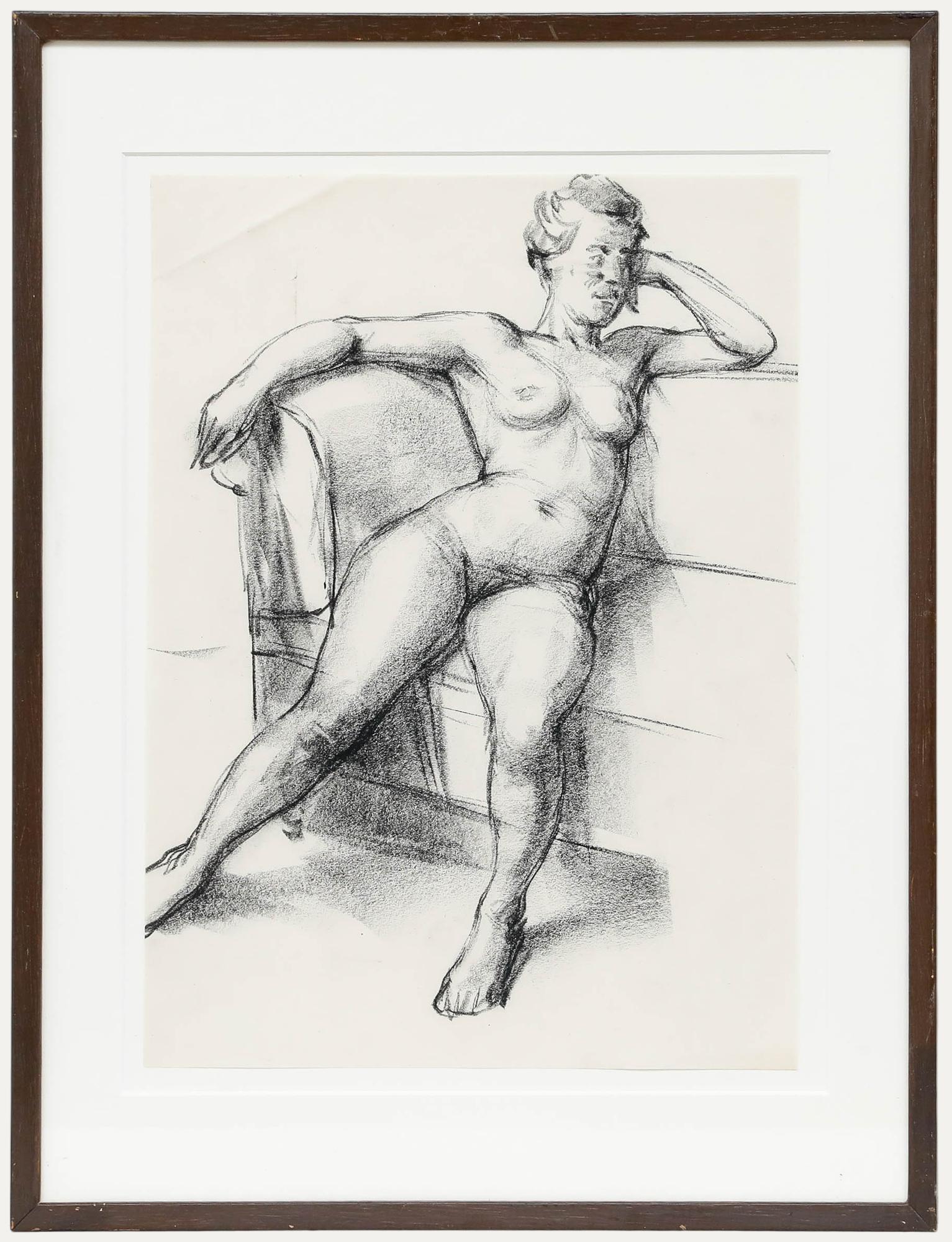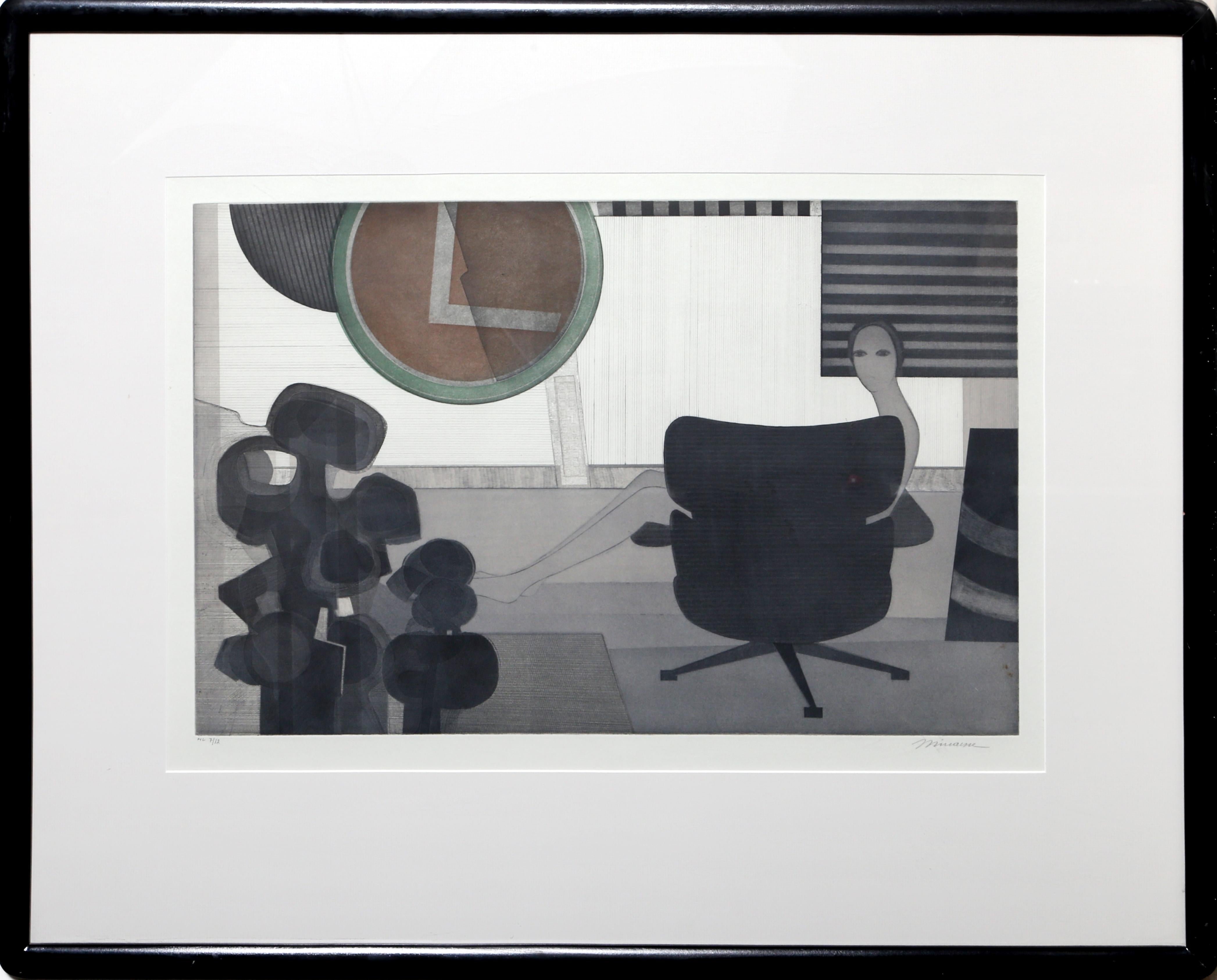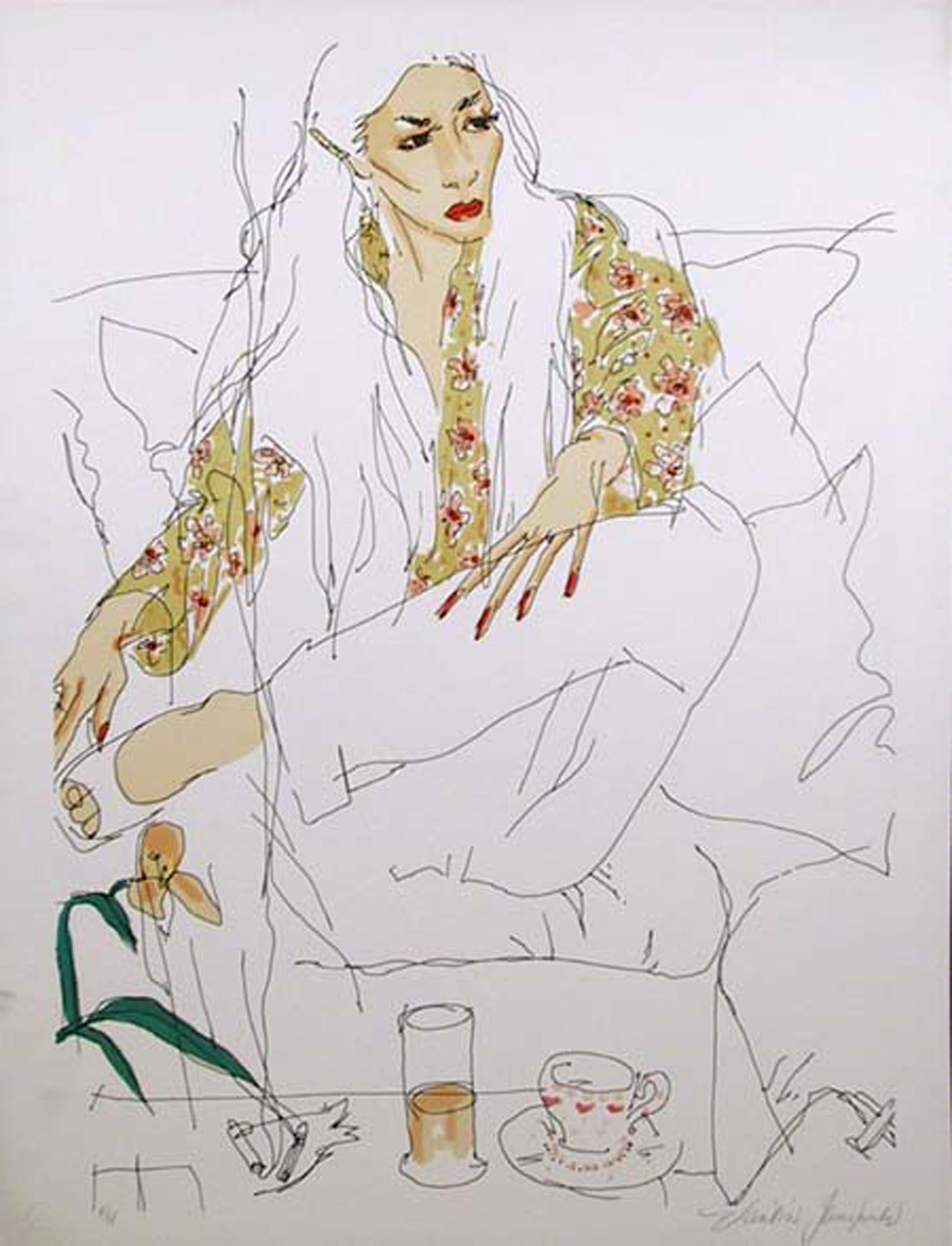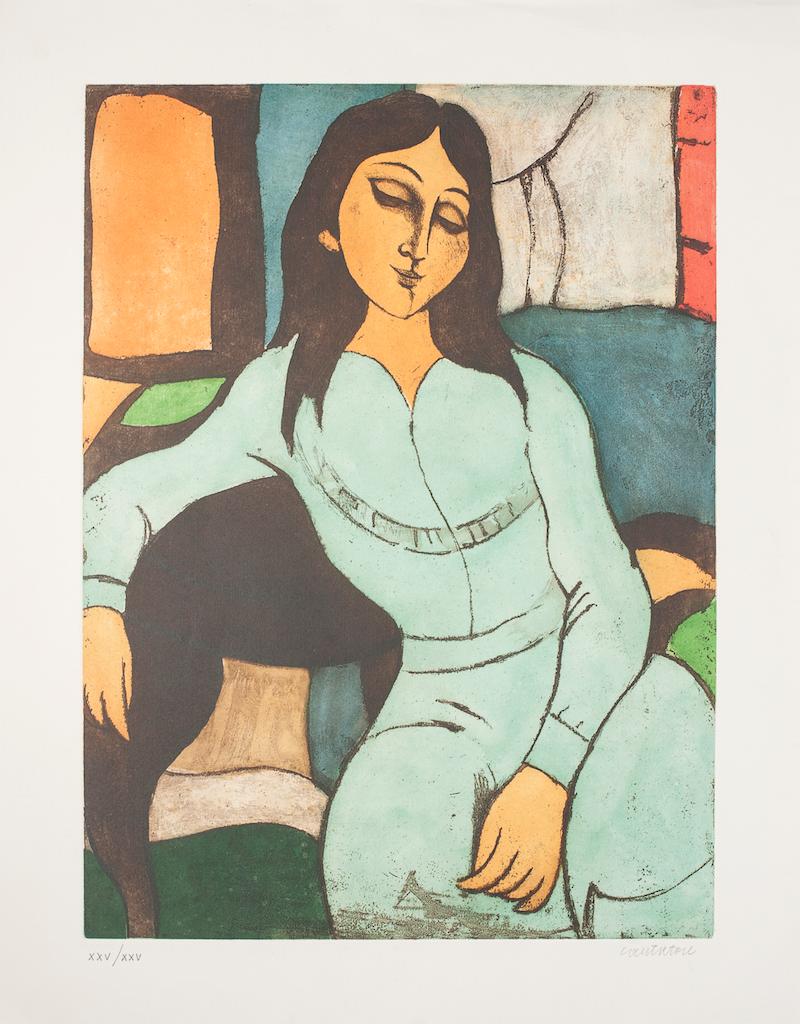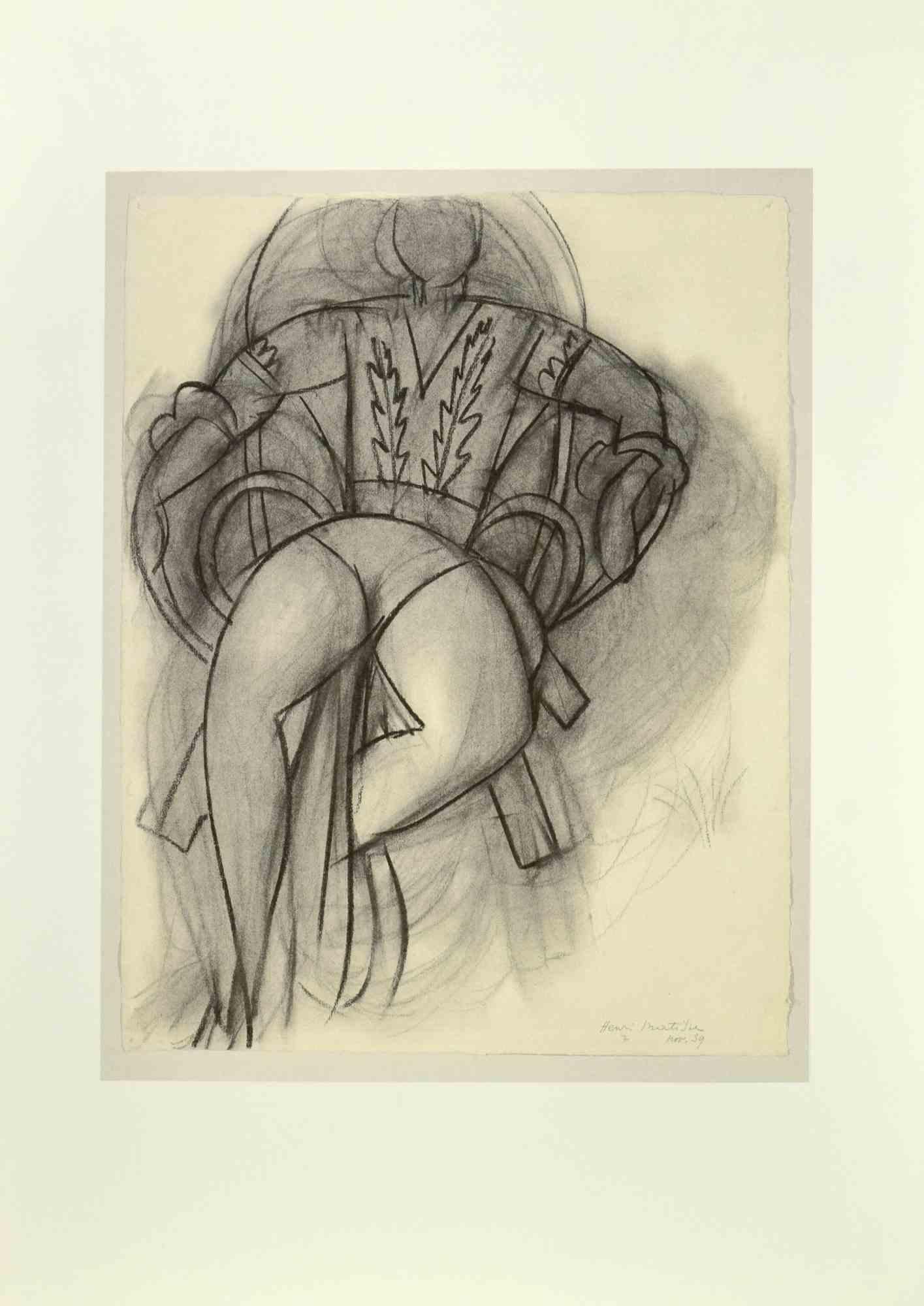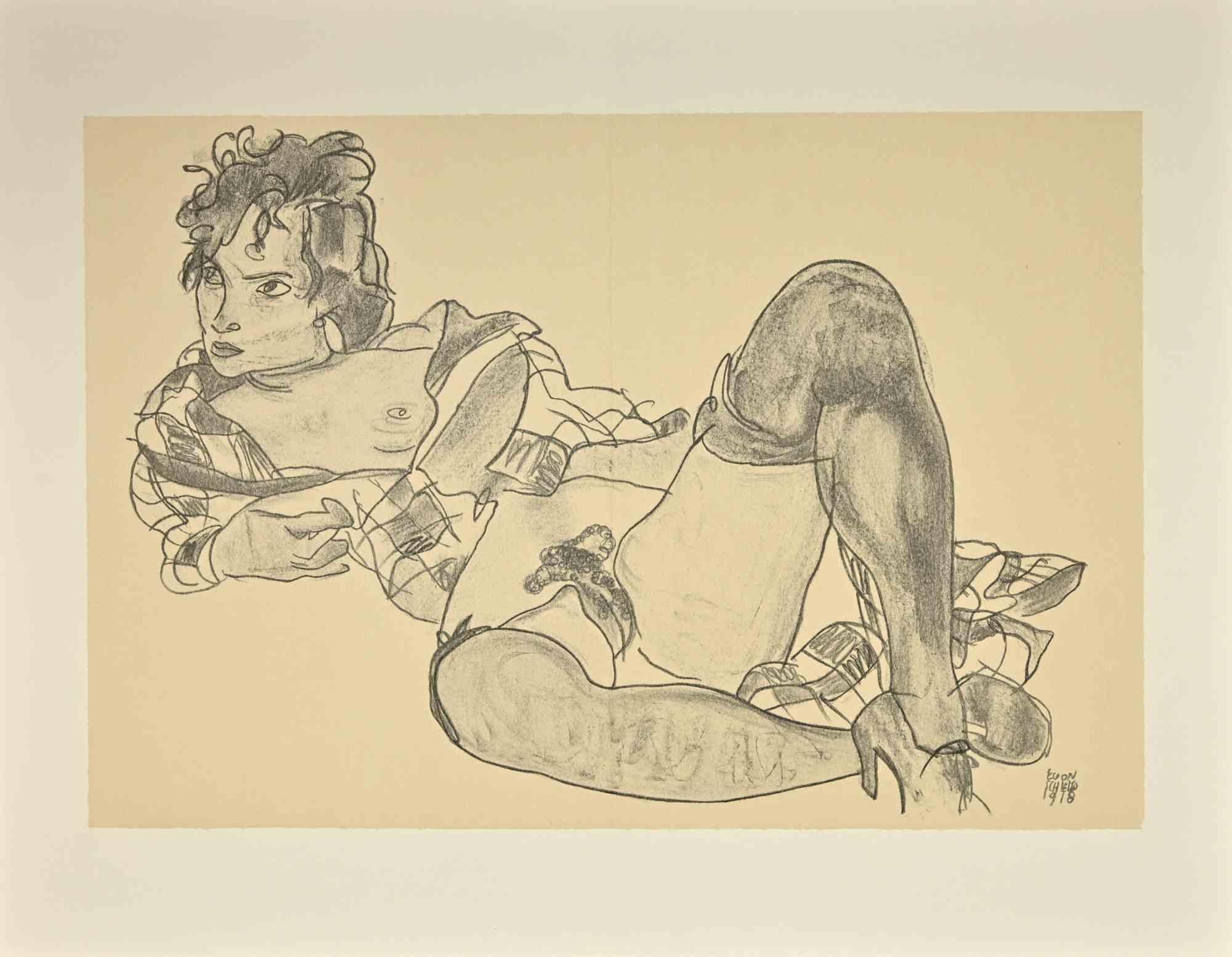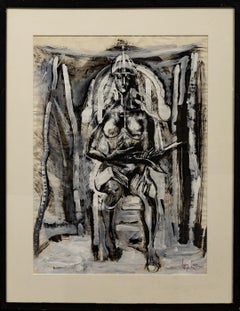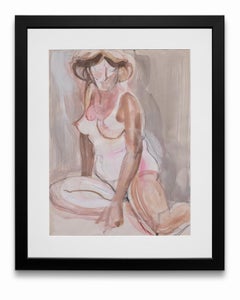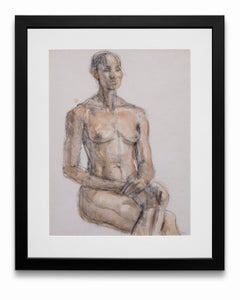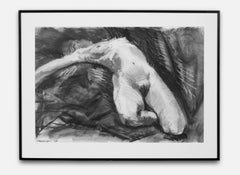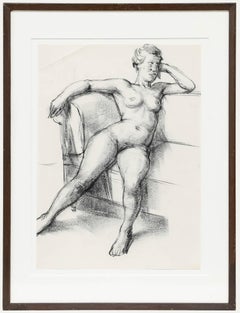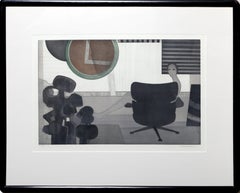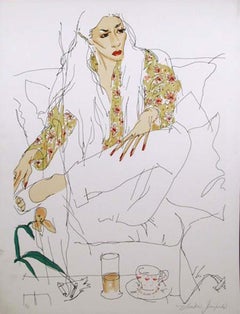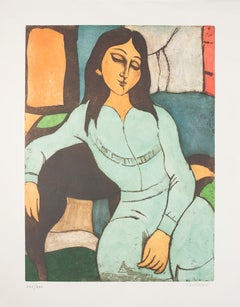Items Similar to Arnold Singer "Woman on Arm of Sofa" Lithograph Linear Black & White
Want more images or videos?
Request additional images or videos from the seller
1 of 11
Arnold SingerArnold Singer "Woman on Arm of Sofa" Lithograph Linear Black & White1969
1969
$1,250
£949.22
€1,087.34
CA$1,775.04
A$1,941.63
CHF 1,015.13
MX$23,387.43
NOK 12,687.73
SEK 11,969.09
DKK 8,116.89
About the Item
“Woman on Arm of Sofa” is an extraordinary lithograph by Arnold Singer. You could say it is representative of his interests in several art styles that are combined in this lithograph with utmost success. The rendition of the figure and the sofa into black graphic lines is certainly an abstraction while the overall composition of a woman seated on a sofa is a typically classical pose.
Singer has the unique distinction of holding high regard not only for abstraction, but formal classicism, two visually opposite styles. He was very much influenced by abstraction and what at the time was referred to as “non-objective” abstraction, Singer focused a great deal on the study of the human figure and the urban environment – a source of imagery seemingly at odds with the most rigorous forms of abstraction and likewise the most rigorous forms of Classicism. As a result, he forged an approach to image making that combined the formal purity of abstraction and the intense observation of nature found in Classicism.
Arnold Singer was a native of New Yorker where he was born and raised. He attended the Art Students League studying under artist/teachers Bridgman, Nicolaides, and Abels. During World War II, Singer served as a camouflager for the Corps of Engineers returning to the Art Students League after the war to work under the guidance of Cameron Booth, Byron Browne, and most importantly, Will Barnet, who remained a long-time friend and mentor and Joseph Pennell, who founded their printmaking department – the first in the country.
While at the Art Students League, he gravitated to a group of young artists interested not only in the European modernist tradition of Picasso, Mondrian, Cezanne and Matisse, but also Gothic and Romanesque painting, and 18th and 19th century classicism. His interests extended to works produced by indigenous peoples of Africa and the Northwest Coast of the North American Continent. He eventually taught printmaking at the League as well as at Pratt Graphic Arts Center, where he became a master printer. He introduced the medium to many leading American artists and printed editions for Rufino Tamayo, Stuart Davis, Larry Rivers, Ellsworth Kelly, Adolf Gottlieb and Barnett Newman.
In 1966 moved to Ithaca to teach lithography, painting and drawing for more than 20 years in the Department of Fine Arts at Cornell. He, in fact, inaugurated the program in lithography at Cornell. He eventually became known as the ultimate American authority on lithography.
Singer had solo exhibitions at the Arkansas Art Center in Little Rock; the Pratt Graphic Arts Center; The Gallery in Morgantown, West Virginia; and at Wells College in Aurora, New York. He participated in numerous exhibitions at the Chicago Art Institute, the Philadelphia Print Club, the Brooklyn Museum, and the Kornblee Gallery in New York City. Internationally he showed at the Studenterforenigen in Denmark and the Galeria Wstolzesna in Warsaw. He has been collected by many private and corporate patrons in addition to the Brooklyn Museum, the Pasadena Art Museum, and the Print Club in Philadelphia.
Titled, signed and dated by artist
Lithograph #1/20
- Creator:Arnold Singer (American)
- Creation Year:1969
- Dimensions:Height: 25.75 in (65.41 cm)Width: 20.5 in (52.07 cm)
- Medium:
- Movement & Style:
- Period:
- Condition:
- Gallery Location:Detroit, MI
- Reference Number:1stDibs: LU128619241052
About the Seller
5.0
Vetted Professional Seller
Every seller passes strict standards for authenticity and reliability
Established in 2014
1stDibs seller since 2019
108 sales on 1stDibs
Typical response time: 17 hours
- ShippingRetrieving quote...Shipping from: Detroit, MI
- Return Policy
Authenticity Guarantee
In the unlikely event there’s an issue with an item’s authenticity, contact us within 1 year for a full refund. DetailsMoney-Back Guarantee
If your item is not as described, is damaged in transit, or does not arrive, contact us within 7 days for a full refund. Details24-Hour Cancellation
You have a 24-hour grace period in which to reconsider your purchase, with no questions asked.Vetted Professional Sellers
Our world-class sellers must adhere to strict standards for service and quality, maintaining the integrity of our listings.Price-Match Guarantee
If you find that a seller listed the same item for a lower price elsewhere, we’ll match it.Trusted Global Delivery
Our best-in-class carrier network provides specialized shipping options worldwide, including custom delivery.More From This Seller
View All"Nude on Throne" Female, Frontal, Symbolism, Black & White, Abstract
By Artis Lane
Located in Detroit, MI
"Nude on Throne" shows a beautiful strong young woman seated upon what appears to be a ancient throne. There are objects held by her and placed on her legs, one of which can clearly ...
Category
Late 20th Century Contemporary Figurative Drawings and Watercolors
Materials
Paper, Watercolor, Mixed Media
"Seated Female", Mixed Media on Paper
By Artis Lane
Located in Detroit, MI
This mixed media on paper from the seminal artist Artis Lane is one of the many model paintings from her long and illustrious career. The subject is a nude woman sitting in pose. Artis Lane, in her many nudes, chose to depict a diversity of bodies, of all shapes, colors, and sizes. This work was recently exhibited adjunct to the "Steps Towards Justice: Artis Lane's Portraits of Rosa Parks" exhibition at Collected Detroit in 2021. The matte of this work is 31 x 25.75 inches while the image is 25.5 x 19 inches.
Most recently in January 2021 Ms. Lanes' dynamic sculpture bust of Rosa Parks was chosen from the National Portrait Gallery in Washington DC to reside in the President's Oval Office as a reminder to all who visit or see it via press photographs of her courageous demand for equal rights. It is a constant source of inspiration.
All my life I have worked on three levels of consciousness: Portraits, Social Injustice & Metaphysics. In my work I strive to heal, uplift and inspire viewers and collectors to find perfection in their own being. - Artis Lane
Artis Lane lived and worked in Los Angeles for over twenty years. She knew many celebrities, movie stars and individuals who moved in those circles. She was a sought after portrait painter. This particular painting of the famous movie star, Zsa Zsa Gabor, shows why. Artis has captured the personal essence of her subject, a warm, friendly woman, though famous, is not absorbed in her notoriety. This piece is signed by the artist on the lower right.
Born Artis Marie Shreve in 1927, near an all-Black village in North Buxton, Ontario, Canada. After three years of art college in Toronto, Canada, Artis moved to Detroit where she met and married journalist and activist Bill Lane. In Detroit Artis Lane continued her training at Cranbrook Academy of Art in Bloomfield Hills, Michigan. Cranbrook was designed by architect and faculty member, Eliel Saarinen who collaborated with Charles and Ray Eames on chair and furniture design. Numerous creative artists who are alumni of Cranbrook include: Harry Bertoia, Florence Knoll, Jack Lenor Larsen, Donald Lipski, Duane Hanson, Nick Cave, Hani Rashid, George Nelson, Urban Jupena (Nationally recognized fiber artist), Cory Puhlman (televised Pastry Chef extraordinaire), Thom O’Connor (Lithographs), Paul Evans (Brutalist-inspired sculpted metal furnishings), Eugene Caples (small bronze images/abstract), Morris Brose (Bronze Sculptures), Herb Babcock known for blown glass) and Larry Butcher (mixed media abstract artist.)
While in the Motor City she painted and sculpted the portraits of many of the business and political leaders of the day; Governor George Romney, Ford family members and Coleman Young, the Mayor of Detroit. After her divorce, she was invited by Diahann Carroll to move from Detroit to come live in New York City where she met and married, Vince Cannon. They spent time in Texas, Ruidoso, New Mexico and traveled to Mexico City, Mexico to paint many of the prominent families in the region. Eventually she settled in Los Angeles and has recently relocated to Detroit.
Her portrait and sculpture work has depicted dignitaries like Jaqueline Kennedy, Nelson Mandela, Gordon Getty, President Reagan, President Obama, First Ladies, Hillary Clinton and Michelle Obama, Mrs. Walter Annenberg, Nancy Kissinger, including her most recent portrait commissioned by Academy Award winner, Jaime Fox. It’s an elegant painting of Oprah Winfrey, which was unveiled live on her show. Artis Lane has sculpted Don Cornelius, Quincy Jones, Lupita Nyong’o, Lena Horne, Stevie Wonder, and Magic Johnson, and many more.
In the 1970’s, social issues became the next focus of her work, which included “Tear on the Face of America,” her civil rights statement, and “The Beginning,” a now famous painting depicting a young Rosa Parks seated in the fateful bus. Artis was honored by the Smithsonian National Portrait Gallery in Washington DC during the installation of her bronze sculpture of civil rights leader and longtime friend, Rosa Parks. In 1999, she was selected to execute and design the Congressional Medal of Honor awarded to Ms. Parks.
“My Civil Rights images led me naturally to ideas about what and who we are outside of race.
I went from there to the most important body of work, the metaphysical images of generic man and generic woman emerging out of the ignorance of material concepts and evolving into spiritual awareness.” Artis Lane.
The bigger challenge was to create art that could symbolize and communicate certain spiritual truths that have guided Lane’s life and creative endeavors for most of her adult years and led to her Metaphysical work. She leaves the workings of the foundry: the gaiting material, ceramic shell mold, etc., (the “birthing” materials of the foundry), on the bronze to symbolize generic man emerging out of material thinking into spiritual consciousness. She then shows the work in pairs… the traditional black patina bronze, with the ceramic shell pieces as a metaphor for the moralistic/materialistic conversations that mankind has wrestled with throughout eternity.
The new millennium brought new challenges and celebrations of her work. At the age of 80, Lane was commissioned to create a 12ft bronze of her “Emerging First Man.” The sculpture was created for an 1100 acre private estate community in Atlanta, GA. In 2007, she was honored by The California African American Museum with a retrospective of her life’s work which included almost 100 works of art. In 2009, First Lady Michelle Obama unveiled Lane’s bust of Abolitionist and Suffragette, Sojourner Truth, which was the first African American woman to be installed in the new Emancipation Hall and is now a part of the collection of the United States Capitol.
Ms. Lane’s solo exhibit, “The Art of Artis Lane,” at the Forest Lawn Museum, Glendale, Ca in 2011, brought a thought provoking retrospective of her art to the public including the “Divine Metaphysics” series. Her bust of Arnett Hartsfield, Jr., Pioneering Firefighter & Activist, unveiled at The African American Firefighter Museum in Los Angeles in 2012. The California African American Museum in Los Angeles, mounted a retrospective exhibition entitled “A Woman’s Journey: The Life and Work of Artis Lane” in 2007/2008 and subsequently honored her with its Lifetime Achievement Award. Lane presented an official portrait of Los Angeles Mayor Antonio Villaraigosa, which was unveiled at City Hall by Mayor Eric Garcetti in 2014. All are merely a few recognitions of her achievements over the decades. Lane’s HistoryMakers interview was made a permanent part of the Library of Congress Collection in 2014. Her Artwork is displayed around the world.
Artis has been a constant presence at the openings of her artistic colleagues in the region. As one of the honored “elders,” she provides encouragement and support for the younger African American artists who strive to use their own talents to express visions of social, ethical, and spiritual importance. She is, in short a force of nature whose life and work have graced both her native Canada...
Category
Late 20th Century Nude Paintings
Materials
Paper, Mixed Media
Price Upon Request
"Seated Woman", Mixed Media on Paper
By Artis Lane
Located in Detroit, MI
This mixed media on paper from the seminal artist Artis Lane is one of the many model paintings from her long and illustrious career. The subject is a nude ...
Category
Late 20th Century Nude Paintings
Materials
Paper, Mixed Media
Price Upon Request
"Female Nude" Charcoal Sketch, Nude Female
Located in Detroit, MI
SALE ONE WEEK ONLY
"Nude Female" by Eric Saarinen is an intimate portrait of a female that appears to be in the throes of orgasm. It is aesthetically re...
Category
Late 20th Century Contemporary Nude Drawings and Watercolors
Materials
Charcoal
"Seated Figure With Cigarette", Partially Nude Female, Watercolor on Paper
By Robert Andrew Parker
Located in Detroit, MI
"Seated Figure With Cigarette" is distinctly vibrant and sexual with a feminine-mystique glow in this stunning example of Robert Parker's Expressionist watercolor. Its colors mesh wi...
Category
1970s Figurative Paintings
Materials
Paper, Watercolor
"Seated Male Nude", Charcoal on Paper
By Artis Lane
Located in Detroit, MI
This charcoal on paper from the seminal artist Artis Lane is one of the many model paintings from her long and illustrious career. The subject is a nude mal...
Category
Late 20th Century Nude Paintings
Materials
Paper, Charcoal
Price Upon Request
You May Also Like
Peter Collins ARCA - 20th Century Charcoal Drawing, Nude on Sofa
By Peter Collins ARCA
Located in Corsham, GB
Unsigned. Presented in a black strip frame. On paper.
Category
20th Century Nude Drawings and Watercolors
Materials
Charcoal
Seated Woman, Etching by Andre Minaux
By Andre Minaux
Located in Long Island City, NY
Seated Woman
Andre Minaux, French (1923–1986)
Etching, signed and numbered in pencil
Edition of HC 7/12
Image Size: 15 x 23 inches
Frame Size: 27.5 x 34.2...
Category
1970s Modern Figurative Prints
Materials
Etching
Seated Woman, Contemporary Lithograph by Vasilios Janopoulos
Located in Long Island City, NY
Vasilios Janopoulos, Greek (1953 - ) - Seated Woman, Year: circa 1979, Medium: Lithograph, signed in pencil, Edition: AP, Size: 27 in. x 20.5 in. (68.58 cm x 52.07 cm)
Category
1970s Contemporary Portrait Prints
Materials
Lithograph
Sitting Woman - Original Lithograph by Domenico Cantatore - 1970s
By Domenico Cantatore
Located in Roma, IT
Sitting Woman is a beautiful original lithograph realized by the Italian master Domenico Cantatore.
A wonderful original print representing a seated woman through vivid color in a w...
Category
1970s Contemporary Figurative Prints
Materials
Lithograph
Seated Woman - PhotoLithograph after Henri Matisse - 1993
By (after) Henri Matisse
Located in Roma, IT
Photolithograph realized in 1993 after Henri Matisse.
On Milano handmade paper.
It belongs to the edition "H. Matisse, The Color of Light", by Seat Editore.
Category
1990s Modern Figurative Prints
Materials
Lithograph
Reclining Woman - Lithograph - 2007
By Egon Schiele
Located in Roma, IT
Reclining Woman is a beautiful lithograph from the portfolio " Erotica " by Egon Schiele.
It is a reproduction of the homonym black crayon drawing, a self-portrait realized by the...
Category
Early 2000s Modern Portrait Prints
Materials
Lithograph
More Ways To Browse
Northwest Coast
19th Century Two Seater Sofa
White 1960 Couch
Figure Sofa
Scalpel Vintage
Scottish Stag Paintings
Sea Turtle Painting
Seaside Vintage Posters
Silent Film Poster
Silent Movie Posters
South Pacific Art
Sporting Dog Paintings
Springer Spaniel Art
Tim Woolcock
Timothy Barr
Tintin Poster Vintage
Tom Laser
Van Gogh Vintage Poster
